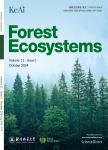Silver flr tree-ring fluctuations decrease from north to south latitude—total solar irradiance and NAO are indicated as the main influencing factors
作者机构:Faculty of Forestry and Wood Sciences Czech University of Life Sciences Prague Forestry and Game Management Research Institute Czech Academy of Sciences Institute of Vertebrate Biology Faculty of Environmental Sciences Czech University of Life Sciences Prague Department of Earth and Environmental Sciences University of Pavia Forests of the Czech Republic SOE School of Agricultural Forestry and Environmental Sciences University of Basilicata
出 版 物:《Forest Ecosystems》 (森林生态系统(英文))
年 卷 期:2023年第6期
页 面:717-731页
核心收录:
学科分类:09[农学] 0903[农学-农业资源与环境]
基 金:supported by the Czech University of Life Sciences Prague Faculty of Forestry and Wood Sciences (No. IGA A_21_26) the Ministry of Agriculture of the Czech Republic (No. QK1910292 and QK21020371)
摘 要:Silver flr(Abies alba Mill.) is a flexible European tree species, mainly vegetating within the mountainous regions of Europe, but its growth responses across its latitudinal and longitudinal range have not yet been satisfactorily verifled under changing environmental conditions. This study describes the tree-ring increment of silver flr in research plots across a latitudinal gradient from the northern range in Czechia(CZ), through Croatia(HR) to the southernmost range in Italy(IT). The research aims to analyze in detail the dynamics and cyclicity of the ringwidth index(RWI) and how it relates to climatic factors(temperature and precipitation), the North Atlantic Oscillation(NAO), and total solar irradiance(TSI), including the determination of latitude. The results show that the main drivers affecting flr growth are the seasonal NAO index and TSI. Monthly temperatures affect RWI early in the vegetation season, while lack of precipitation during the summer is a limiting factor for flr growth,especially in July. Seasonal temperatures and temperatures in June and July negatively impact, while seasonal precipitation totals in the same months positively influence the RWI in all research plots across meridian. The longest growth cycles in flr RWI were recorded in the northernmost studied plots in CZ. These cyclical fluctuations recede approaching the south. The cyclic increase in RWI is related to the TSI, which decreases its effect from north to south. The TSI?s effects vary, positively impacting CZ but negatively influencing HR while remaining relatively neutral in IT. On the other hand, seasonal NAO tends to negatively affect silver flr growth in HR and CZ but has a mildly positive effect in IT. In conclusion, the TSI and the influence of the seasonal NAO index are prevalent in the flr RWI and are accompanied by a greater cyclicity of RWI in Central Europe(temperature optimum) than in the Italian Mediterranean region, where this tree species is limited by climatic condi




